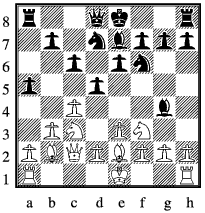
April 2013
There is certainly not much in it as we join the game for RR's ninth move.

|
| RR v Steve Dean after 8 ... Nbd7 |
9 d4 Bf5, 10 Bd3 Bxd3, 11 Qxd3 Bb4 The disadvantage of not having already castled, black can force off one of my knights. Methinks his game plan will revolve around leaving me with a bad bishop.
12 O-O Bxc3, 13 Bxc3 Ne4, 14 h3 Another silly rook's pawn nudge. Seem to have made plenty of those this weekend. Doubtless I wanted to dissuade him from any thoughts of a kingside attack, but its really not necessary. Now in order to dislodge his knight with f3 I shall need to guard against in arriving on g3. Could be a Bf1 move. Tons of preparation needed. Ugly.
14 ... O-O, 15 cxd5 exd5 Opening up the centre is liable to favour the side whose pieces are better developed, black in this case, but I've decided on a plan B that doesn't involve all the effort needed to permanently expel enemy knights from e4. I'm ahead on time. Now to give him a decision.
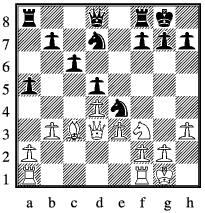
|
| RR v Steve Dean after 15 ... exd5 |
16 ... a4 True to type, Steve elects to keep the position under control
17 b5 But RR refuses to play ball. If he won't take on b4, I'm going to mess those queenside pawns one way or other. A slightly less lengthy think.
17 ... Nxc3 Steve abandons the bad bishop plan, and goes for a extra pawn at a cost of pawn weaknesses set-up. RR is feeling much happier than a few moves earlier.
18 Qxc3 cxb5, 19 Rab1 Not needing to guard the a-pawn from a frontal attack RR has a rook for each of the b and c files.
19 ... Qa5, 20 Qxa5 Rxa5, 21 Rfc1 f5 Steve's turn to lash out, but the alternatives seem to involve becoming very passive in attempts to hold his pawns together, rarely a successful ploy.
22 Rc7 Nb6, 23 Rxb7 That's my pawn back.
23 ... Nc4, 24 R1xb5 now a pawn up
24 ... Rxb5, 25 Rxb5 f4, 26 exf4 Rxf4, 27 Rxd5 two pawns up
27 ... h6, 28 Rc5 Nb2, 29 Rc2 Nd3, 30 Rc3 Nb2, 31 Rc2 Nd3, 32 Rd2 out damned knight!
32 ... Nb4, 33 d5 here the pawn is no longer protected by my knight, but I'm not having him use d5 for his knight. By now he's more concerned about making the time control after 36 moves than anything else.
33 ... Kf8, 34 a3 Na6, 35 Rc2 Ke8, 36 Rc6 Nb8 1-0 making the time control, and then resigning as my next and obvious move will add some horsemeat to the menu, something that the chess populace are not squeamish about.
comment on this article
Division 1
|
Division 2
|
Division one started with a bang, with Stafford A sending 950 grading points worth of players to duff up Newcastle, which they duly did. That's the strongest team gradewise since the grading alterations, and roughly on a par with some of the Cheddleton sides in season 2006/7. A further win over Holmes Chapel leaves Stafford in pole position, needing two points from a double header against pointless Alsager to clinch the title.
Cheddleton C claimed the second division title by beating Knights, and a Cheddleton one-two looks likely with just three postponed matches outstanding.
Division 3
|
Division 4
|
The division four title seems to be heading to Fenton, their B team needing to retain their nerve over their closing matches to be top of he pile. At the other end of the table Newcastle E picked up three points in two matches to move away from the Tiny Pawns who now look destined to receive the wooden spoon.
Newcastle and Cheddleton qualified for the Intermediate Cup Final with wins over Stafford and Holmes Chapel respectively.
A few defaults to report: Alsager C were a board short against Fenton B, Tiny Pawns two short at Alsager D, and Macclesfield defaulted a second division match to Cheddleton B. I suspect there were good reasons for most if not all of these.
In the County Cups Stafford have reached the Hickman final, Fenton the Jackson final and Newcastle the Withnall final. Cheddleton will contest the Gothard final, a competition whose small entry precluded Cheddleton from having any other matches within it. The finals were all to have taken place at Stafford, but with the loss of St Leaonard's as a venue I have not heard whether alternative plans have been made.
On the individual front Malcolm Armstrong took advantage of Rob Shaw's snowbound state to move to the top of the Strong Players GP by convincingly winning the third event, whilst Ben Scattergood, Richard Cantliff and Dominic Taylor respectively won the Open, U130 and U100 sections at the Newcastle Congress where the U160 top spot was shared by John Day, Brian Birchall, Ken McNulty and Alex Cartlidge.
comment on this article
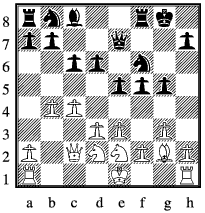
|
| Rob Taylor v RR after 10 ... Qe7 |
12 bxc6 bxc6, 13 cxd5 cxd5, 14 Nf3 h6 Although this was not an automatic response, I stil winced inwardly whilst Rob considered his continuation I seem to have given him time to play d4, whereas an immediate g4 from me would have sent the knight on its way, effectively gaining me a tempo. Fortunately Rob decided to test whether I'd be prepared to open the h-file.:
15 h4 g4, 16 Nd2 Be6, 17 Qb2 Nbd7, 18 0-0 Rab8
19 Nb3 a5, 20 Qd2 a4, 21 Na5 Qb4 This seemed a good way of penetrating with a major piece, but Rfc8 would be better. If white tries facing rooks I then have Nc5 from which square the knight is difficult to dislodge without ceding control over e4.
22 Qxb4 Rxb4, 23 Nc6 Rb2, 24 Nc3 diagram right
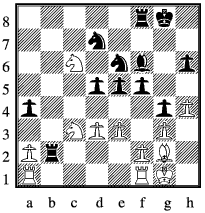
|
| Rob Taylor v RR after 24 Nc3 |
24 ... Kf7, 25 Nxa4 Rd2, 26 d4 e4 (Ne4 better eg
26 ... Ne4, 27 dxe5 Ra8, 28 Bxe4 dxe4, 29 Nc3 Rc8, 30 Nb1 Rxa2 and the e5 pawn soon falls. Equally
26 ... Ne4, 27 Nxe5+ Nxe5, 28 dxe5 Ra8 and black's position eases.)
27 Rfb1 Rc8 hitting the wrong knight. White has to take more care after Ra8.
28 Rc1 Ke8 How about Ne8, eyeing c4 in a couple more hops?
29 Bf1
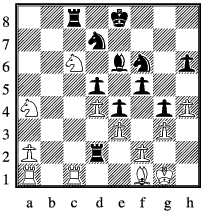
|
| Rob Taylor v RR after 29 Bf1 |
29 ... Nb8, 30 Bb5 Bd7, 31 Nb6 No he hasn't!
31 ... Rxc6, 32 Nxd7 a further mistake based on overlooking his capturing knight stops my rook being pinned against the king. After
32 Bxc6 Nxc6 he has given up two pieces for the rook.
32 ... Rxc1+, 33 Rxc1 Nbxd7, 34 a4 Ra2, 35 Rc8+ Ke7
36 Rh8 h5 How often do I think of a decent line, and then go for something inferior? I rejected
36 ... Nf8, 37 Rxh5 Kf7 with intent to trap the rook on flimsy thoughts of his using his h-pawn to support the rook. Clearer thought shows that this is not possible. Instead I leave the rook at large.
37 Ra8 Rb2, 38 Ra7 Kd8, 39 Ra8+ Kc7, 40 Ra7+ Kc8 offering the draw as that would be enough to secure the match and it is not immediately apparent how I'm going to unwrap my pieces to take advantage of the material superiority. We never did resolve that, for Rob felt obliged to accept the offer, it being even less clear how he could play for a win against someone content to sit on the position.
comment on this article
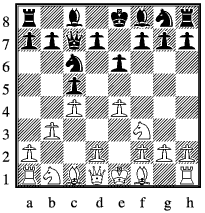
|
| RR V Karol Grzybowski after 4 ... Qc7 |
5 d4 cxd4, 6 Nxd4 Qe5 forking the win of the knight and the e4 pawn.
7 Nc2 Qxe4+, 8 Be3 Nf6, 9 f3 hardly the best kick, as it removes a defender from the bishop.
9 ... Qe5, 10 Be2 Be7, 11 0-0 0-0, 12 Nd2 d5, 13 f4 Qc7
14 Bd3 e5, 15 fxe5 RR captures the wrong pawn ...
15 ... Nxe5, 16 Nf3 dxc4 ... and finds himself dropping a second one
17 bxc4 Nxc4, 18 Bd4 Bg4
RR now has a plan of sorts, but Karol has time to thwart it, possibly by natural moves. RR's biggest problem, other than material deficiency, is the exposure of his king, and perhaps rather than commencing a flawed plan would be better simply to play Kh1 to see Karol's response.

|
| RR V Karol Grzybowski after 18 ... Bg4 |
The rest consists of fruitless attempts to get activity or just to find squares for the white queen on an open board dominated by the black bishop pair:
24 Bxc4bxc4, 25 Ne3 Be6, 26 Rb7 Should take the c-pawn and hope that somehow a drawing endgame can be reached. The c-pawn is about to become dangerous, and the rook penetrating to the seventh achieves nothing.
26 ... c3, 27 Qb4 Bxa2, 28 Qa4 Be6, 29 Qe4 Rfe8, 30 Qc6 Qa5
31 Ra7 (how desperate can you get?) Rac8
32 Qe4 c2, 33 Nxc2 Bf5, 34 Qb4 Qa2, 35 Ncd4 Bxd4, 36 Nxd4 (queen take better, though the game is long gone)
36 ... Qf2, 37 Rg1 Be4, 38 Nf3 Bxf3 0-1
comment on this article
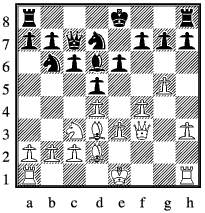
|
| RR v Matthew Wyza after 11 ... Nf6d7 |
12 e4 dxe4, 13 Nxe4 Nd5, 14 Nxd6+ Qxd6, 15 c4 Nb4
Optimism and pessimism combine to cause disaster. The optimistic thought that c4 would force a retreat are joined by pessimistic thoughts that I need to use my bishop to protect c2 and have to worry about my d-pawn. Be4 works fine despite silly worries about f5. Bb1 is OK even though it cuts off castling. In either case the d-pawn is safe as white has say
16 Bb1 Qxd4, 17 Bxb4 Qxb2, 18 Bc3 to emerge ahead.
Maybe if I hadn't been optimistic last move I could think straight this one, but maybes never did anyone any good.
16 Bc3 Nxd3+, 17 Qxd3 Qxf4, 18 Bd2 Qh4+, 19 Kd1 0-0-0
20 Qe3 Nb6, 21 b3 Rxd4, 22 Kc2 Rhd8, 23 Bc3 surely Rad1 to at least get it into the game, but I'm totally at Matthew's mercy anyway.
23 ... Re4, 24 Qf3 Rf4, 25 Qe3 Rf2+, 26 Kc1 Rg2
27 Be1 Will he? Qxg5 he does! (Nxc4 is crushing).
28 Qxg5 Rxg5, 29 Bh4=
A generous offer that RR felt obliged to accept. Matthew has 3 pawns for the exchange and RR has still to find a way of getting the a-rook into the game.
comment on this article
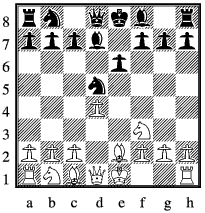
|
| Simon Edwards v RR after 6 Nf3 |
6 ... Bd6, 7 0-0 0-0, 8 Bg5 f6 The logical consequence of my chosen bishop development.
9 Bh4 Nc6, 10 a3 Qe8, 11 Re1 g5 No hanging around, but black is perhaps better served by first playing Rd8 to help with the centre, and/or Qf7 in anticipation of creating f-file pressure. RR still has a tendency to charge in first, and leave regrets till later.
12 Bg3 Qg6, 13 Bf1 h5 RR decides on a pawn storm, though it is not apparent how this will end. maybe should remove the dark squared bishops first to create a half-open file.
14 Bxd6 cxd6, 15 c4 Nde7, 16 Nc3
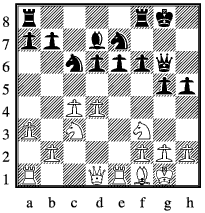
|
| Simon Edwards v RR after 16 Nc3 |
16 ... d5, 17 Bd3 Qf7, 18 b4 We both have a wing attack
18 ... Rad8 may have been good earlier, but if we are in a race to see who can crash through first R should stick to kingside moves as much as possible.
19 b5 Na5, 20 c5 Bc8 Another queenside move. Why? Fine if it brings a halt to white's queenside expansion, but otherwise there must be better play elsewhere.
21 Qa4 Nc4 Deciding that the material loss is better than playing b6 and allowing white a passed pawn whenever he wishes to shove the c-file foot soldier forward.
22 Qc2 Kg7 Not worried about a check but freeing access for the rooks to the h-file.
23 a4 Na5 Fatuous. h4, Rh8 and g4 was the plan. Won't scare the horses, but at least there are possibilities whereas nothing good can come from this. Indeed RR's queenside rapidly disintegrates.
24 Ne2 Rh8, 25 Qc3 b6, 26 cxb6 axb6, 27 Qc7 Rd7, 28 Qxb6 Nc4
29 Bxc4 dxc4, 30 Qc5 Nf5, 31 Qxc4 Bb7, 32 Ng3 Nxg3 Even now RR is making strange choices. Bxf3 at least gives the prospect of opening a file on the enemy king.
33 fxg3 Bd5, 34 Qe2 Rc7, 35 Rec1 Rhc8, 36 Qd2 Rc4, 37 Rxc4 Rxc4
38 a5 Qb7, 39 b6 Bxf3, 40 gxf3 Qxf3, 41 Rc1 Ra4,
(... Rxc1, 42 Qxc1 Qd3 might prove annoying)
42 Qc3
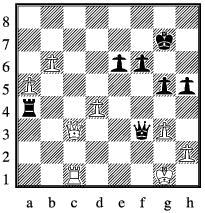
|
| Simon Edwards v RR after 42 Qc3 |
Despite play on opposite sides of the board it is apparent that Simon attacked on a wing, RR on a prayer.
comment on this article
1 f4 f5 Neither of us are much into this stuff, so we'll have to see who can make it up better as we go along.
2 Nf3 Nf6, 3 d3 b6 A typical RR move, played by his opponent.
4 e4 e6 (Not ... fxe4, 5 dxe4 Nxe4, 6 Qd5 ouch)
5 e5 Ng8, 6 d4 d5, 7 exd6 Bxd6 RR should go straight for the backward pawn with Bc4, 0-0 and one or more of Re1, Qe2 and Ng5. Would the pawn live? Instead he goes for a slower (inferior) approach:
8 c4 Nf6, 9 Nc3 0-0, 10 Bd3 Bb4, 11 0-0 Nc6, 12 a3 Be7
13 Bc2 Wanted to play d5 but black has Bc5+ and Ne7 without damage, whilst Be3 by me seems to ask for Ng4 and Bf6.
13 ... Re8 An understandable desire to add to his defence of the e-pawn.
14 b4 Bf8, 15 Ba4 Bd7 (Bb7 loses the exchange after d5)
16 Bb3 The bishop finally gets onto the diagonal with the enemy king
16 ... Bc8, 17 d5 exd5 better to retreat the knight immediately
18 cxd5 Nb8, 19 d6+ Kh8, 20 Ng5 1-0
Black's queen is not long for this world.
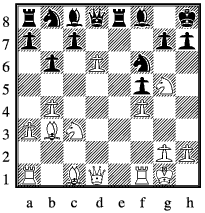
|